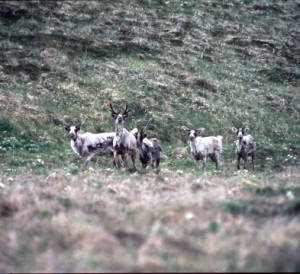Adak Island is home to something you won’t find much of elsewhere in the Aleutians: a herd of caribou, introduced in the 1950s as a hunting option for the naval base. The base has since closed, but the caribou are still there — and lately, some have been striking out for new pastures.
It’s got wildlife refuge managers looking to keep a herd from forming where hunters can’t follow.
Kagalaska Island makes pretty appealing habitat for an enterprising caribou. It’s uninhabited, roomy and full of tasty lichen beds. And it’s just a short swim away from Adak.

Both islands are part of the Alaska Maritime National Wildlife Refuge, where Steve Delehanty is manager. Of the 2,000 or so caribou on Adak, he says a handful have been spotted on Kagalaska in the past two years:
“I’m not a caribou; I don’t know just what’s going through their mind,” he says, “but if you’re standing on Adak, you can look across on a semi-clear day and you can see land there. And caribou are well known to be swimmers, and I guess once in a while, they decide to take the plunge and look for new habitat, a new place to call home.”
Kagalaska’s only about a half a mile away from Adak at its closest point, but Delehanty says the rough water between the two islands makes it impractical to even try to hunt there. And since the Aleutians aren’t home to any of mainland Alaska’s other big mammals — like wolves — the caribou could flourish in their new environment.
“It’s pretty common to have kind of a population boom in an island setting when an animal is brought that doesn’t have any natural predators,” he says. “The population will grow and grow and grow, and sometimes, they’ll sort of eat themselves out of house and home and the population will crash.”
Delehanty says it’s his job to preserve the natural order of the refuge — and the non-native caribou don’t belong. So the refuge is proposing sending staff workers to Kagalaska about once a year, to walk around and shoot any caribou they find.
After that, Delehanty says they’d follow government policy, and decide case-by-case whether it was worth it to salvage and donate a dead animal to subsistence users back on Adak.
“I think everybody prefers that if it’s possible, but there becomes a balance of reasonableness and cost-effectiveness,” he says. “You have to realize how remote this site is, and how logistically challenging this is. And again, there are a couple thousand [caribou] on Adak.”
He stressed that the control plan wouldn’t interfere at all with Adak’s well-established herd, which is a food source and a big tourism draw. On Kagalaska, though, Delahanty says the caribou aren’t just introduced — they’re invasive.
“Even though they’re swimming by themselves to get to Kagalaska Island, they never would have gotten there except for the fact that humans brought them to Adak,” he says. “So it’s kind of a human-originating problem.”
But he’s not sure yet how their human-powered solution will work. Staff could do the caribou control during their annual Aleutian tour on their research ship Tiglax. It’d be convenient, since Adak’s hard to get to otherwise, and it’s already in the refuge budget.
An annual visit to Kagalaska might not be enough, though. Refuge staff set foot on the island so rarely right now that they don’t have good data on how many caribou are moving there, or how often. That’s something else they’d look to find when they went scouting for new herds.
The U.S. Fish & Wildlife Service is still taking public comment on the caribou control plan for Kagalaska Island.
Annie Ropeik is a reporter for KUCB in Unalaska.




